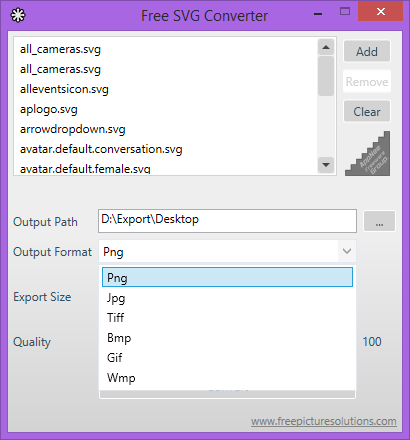

- #Stl to svg converter how to
- #Stl to svg converter pdf
- #Stl to svg converter software
- #Stl to svg converter code
#Stl to svg converter how to
I think there's at least two ways how to add improved image export.ġ) Adding something similar to your script, I guess that could use
#Stl to svg converter code
The code is there but disabled with a comment that it's producing Maybe it's possible to have a switch for antialiasing. In GUI it's essentially just a screenshot. Yes, I think it's using an offscreen OpenGL buffer and renders there > graphics card to render properly - I get different images on my home and > There's no anti-aliasing, and the image seems to be dependent on the > For me, the biggest issue is that "export to PNG" isn't high enough quality. This is rendering the 3D model as an SVG file. for images in a manual).Īs a clarification, this isn't layer slicing - that I can do somewhat easily via other methods.
#Stl to svg converter pdf
Vector files are also useful for embedding in PDF files for accurate display at both print and screen resolutions (e.g.

If I want to weave a 3D image around a cartoon, that's also difficult to do accurately without an SVG rendering. If I want the edges of each surface to be black or grey, I can't do that (very easy to do in Inkscape with SVG files). It's also not particularly friendly for use with other vector graphics images, or for other vector-ish manipulations. If I want to simulate anti-aliasing, I can do the graphics card-like thing and make the image 4x the original size, then resize back to the original, but that get's very fiddly (especially when you can only change the rendered image size by resizing the window). There's no anti-aliasing, and the image seems to be dependent on the graphics card to render properly - I get different images on my home and work computer. The generating openscad file can be found here:īioinformatics Research Analyst, Gringene BioinformaticsĬould you elaborate a bit on what purposes you see for such an SVG file?įor me, the biggest issue is that "export to PNG" isn't high enough quality. I would like to do some simplification of the geometry,Ĭombining adjacent triangles with the same normal into a single polygon,īut am currently doing that manually. On the Z centre of the bounding box, and displayed from back to front. FacesĪre shaded based on the X and Y components of the normal, sorted based Have a normal that has a negative Z component (i.e. a snapshot of the "top" view), culling any faces that It uses the X and Y coordinates of the triangles to draw a 2D image asĪn SVG file (i.e. I wrote my own Perl script to do a basic conversion of a triangle Out if there was any STL to SVG converter, with no luck. As a result, I spent a bit of time hunting around to find Issues with holes in the image, and a file size that was far too big for SVG conversion (traced using Inkscape) without much success. As a result, STL files contain no scale information, and the units are arbitrary.Over the weekend I tried to use OpenSCAD to generate a good PNG file for All STL coordinates were required to be positive numbers in the original specification, but this restriction is no longer enforced, and negative coordinates are commonly encountered in STL files today.

As XML files, SVG images can be created and edited with any text editor but are often created with drawing software.Īn STL file describes a raw, unstructured triangulated surface by the unit normal and vertices (ordered by the right-hand rule) of the triangles using a three-dimensional Cartesian coordinate system. This means that they can be searched, indexed, scripted, and compressed. SVG images and their behaviors are defined in XML text files. Binary files are more common since they are more compact. The STL format specifies both ASCII and binary representations. STL files describe only the surface geometry of a three-dimensional object without representing color, texture, or other common CAD model attributes. It is widely used for rapid prototyping, 3D printing, and computer-aided manufacturing.
#Stl to svg converter software
Many other software packages support this file format. STL is a file format native to the stereolithography CAD software created by 3D Systems. The SVG specification is an open standard developed by the World Wide Web Consortium (W3C) since 1999. Scalable Vector Graphics (SVG) is an XML-based vector image format for two-dimensional graphics with support for interactivity and animation. Model/stl, model/x.stl-ascii, model/x.stl-binary


 0 kommentar(er)
0 kommentar(er)
